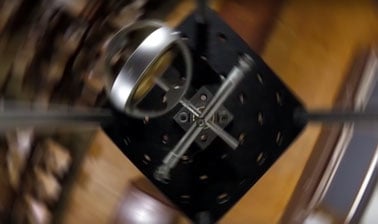The online simulations of forms of energy in physics online on this page let you explore thermal, electrical, chemical, nuclear, and radiant energy. Discover how these energies manifest in different phenomena and processes, how they transform while respecting the law of conservation of energy, and their main applications in science, technology, and daily life.
What are the forms of energy in physics?
The forms of energy in physics represent the various ways energy is manifested and made observable in natural and technological phenomena. Each form of energy is associated with specific processes and can interact or transform into other forms, always respecting the law of conservation of energy. Understanding this classification allows us to systematically study energy and apply its principles in different contexts. In the energy unit, we already reviewed the most well-known forms of energy, kinetic and potential energy. On this page, we focus on other forms of energy, such as thermal, electrical, chemical, and elastic energy.
Additional forms of energy in physics
In addition to kinetic and potential energy, physics includes other forms of energy that are essential for understanding natural and technological processes. Among them are elastic energy (a particular case of potential energy), thermal energy, electrical energy, chemical energy, nuclear energy, and radiant or luminous energy. These forms of energy in physics show how nature stores, transports, and transforms energy, providing the foundation for technologies as diverse as engines, electrical systems, or the generation of solar and nuclear energy.
Elastic energy
Elastic energy is the energy stored in an object when it is deformed, such as stretching a spring or compressing a rubber band. It is a particular case of potential energy, since it depends on the object’s position or configuration. This energy is easily transformed into other forms, for example, into kinetic energy when the object recovers its original shape. Understanding elastic energy is fundamental for analyzing mechanical systems such as springs, elastic pendulums, or structures that absorb impacts.
Thermal energy
Thermal energy is the form of energy related to the movement and vibration of the particles that make up matter. The higher the temperature of a body, the faster its particles move and the greater its thermal energy. This energy is observed, for example, when heating an object causes its molecules to vibrate more intensely, resulting in a temperature increase and sometimes changes in physical state.
Electrical energy
Electrical energy is the form of energy associated with the movement of electric charges through a conductor. It is manifested when electrons flow through a circuit due to a potential difference, generating electric current. This energy is fundamental in daily life, as it enables the operation of electronic devices, lighting, and electric transport, and can be transformed into other forms of energy, such as thermal or mechanical energy.
Chemical energy
Chemical energy is the energy stored in the chemical bonds of molecules and atoms that make up matter. It is released or absorbed during chemical reactions, as occurs, for example, in the combustion of hydrocarbons, cellular respiration, or electric batteries. This form of energy is fundamental for living beings, as it enables processes such as obtaining energy from food, and is also key to the operation of many devices and technologies that depend on fuels and controlled chemical reactions.
Nuclear energy
Nuclear energy is the form of energy stored in the nucleus of atoms and released during nuclear reactions, such as fission and fusion. In nuclear fission, the nucleus of a heavy atom, such as uranium, splits into smaller fragments, releasing a large amount of energy. In nuclear fusion, on the other hand, light nuclei like those of hydrogen combine to form a heavier nucleus, a process that occurs naturally inside the Sun and stars. This type of energy is closely related to radioactivity, a phenomenon consisting of the spontaneous emission of particles and radiation from unstable nuclei. The theoretical explanation of the energy released in nuclear transformations is based on the theory of relativity, which established the equivalence between mass and energy through the famous equation .
Radiant or luminous energy
Radiant energy, also called luminous energy, is the form of energy transmitted by electromagnetic waves, such as visible light, infrared rays, ultraviolet rays, or radio waves. This energy propagates even in a vacuum, which allows sunlight to reach Earth and be one of the main energy sources for living beings and technological systems. From a physical perspective, radiant energy can behave both as a wave (according to classical optics) and as a set of particles called photons, an idea developed thanks to the study of the photoelectric effect.
Transformation of energy
Energy transformation refers to the process by which one form of energy is converted into another. These phenomena occur constantly in nature and technological devices: for example, when dropping a ball from a certain height, its gravitational potential energy is transformed into kinetic energy as it falls; or in a battery, the stored chemical energy is converted into electrical energy that can power a device. These transformations are usually triggered by the interaction between objects, changes in the position or state of matter, or through chemical reactions and physical processes. Understanding how these energy changes occur allows us to predict and control both natural and artificial systems, optimizing the efficient use of energy in different applications.
Applications of different forms of energy
Forms of energy play a key role in understanding and developing science and technology. Thermal energy is used in engines, heating systems, and industrial processes. Electrical energy powers most modern devices and technological networks. Chemical energy is the basis for the operation of batteries, cells, and metabolic reactions in living beings. Nuclear energy is used both in electricity production and in medical research and space exploration. Meanwhile, radiant energy is present in phenomena such as light, the photoelectric effect, and communications.
Explore the exciting STEM world with our free, online simulations and accompanying companion courses! With them you'll be able to experience and learn hands-on. Take this opportunity to immerse yourself in virtual experiences while advancing your education - awaken your scientific curiosity and discover all that the STEM world has to offer!
Simulations of forms of energy
- Elas I
- Elas II
- Conservation
- Changes
- Skate II
Elastic energy I
Another example of energy transformation. Compress the spring and observe how the elastic energy stored in the spring is converted to kinetic energy. What happens if there is no friction?
Law of conservation of energy
This simulation allows us to the law of conservation of energy. Notice how energy changes from kinetic to potential or elastic energy. Why doesn’t the vehicle stop?
Energy Forms and Changes
Explore how cooling or heating iron, brick, water, and olive oil increases or decreases energy. See how energy is transferred between objects. Build your own system, with sources, changes, and uses of energy. Track and visualize how energy flows and changes through your system.
File
Energy skate park II
Learn about energy conservation with a skateboarder! Build tracks, ramps and jumps for the skater and see the kinetic energy, potential energy and friction as he moves. Measure speed and adjust for friction, gravity and mass – you can also put the skater on different planets or in space!
File
- Bicycle
- Vehicles
- Pendulum
- Spring
- Astronaut
- Skate
Kinetic energy of a bicycle
As the person starts pedaling, the speed and kinetic energy increase, do they increase at the same rate?
Kinetic energy, mass and speed
Try to give the same amount of energy to the three vehicles and observe their speeds. Which vehicle moves with more speed for identical energy?
Energy in a pendulum
When the pendulum is released, it begins to swing back and forth. At what point are the kinetic energy of the ball maximum and minimum?
Energy skate park
Learn about energy conservation with a skateboarder! Build tracks, ramps and jumps for the skater and see the kinetic energy, potential energy and friction as he moves. Measure speed and adjust for friction, gravity and mass – you can also put the skater on different planets or in space!
File
Giants of science
“If I have seen further, it is by standing on the shoulders of giants”
Isaac Newton

Galileo Galilei
–

Leonhard Euler
–
Become a giant


Mechanics, Part 2



Mechanics, Part 1



Dynamics and Control



AP® Physics 2: Challenging Concepts



The Basics of Transport Phenomena



AP® Physics 1



AP® Physics 1 – Part 2: Rotational Motion






























